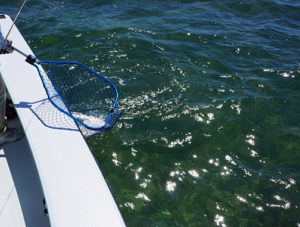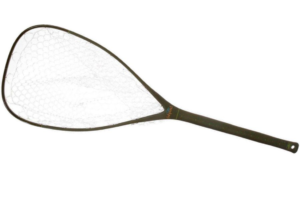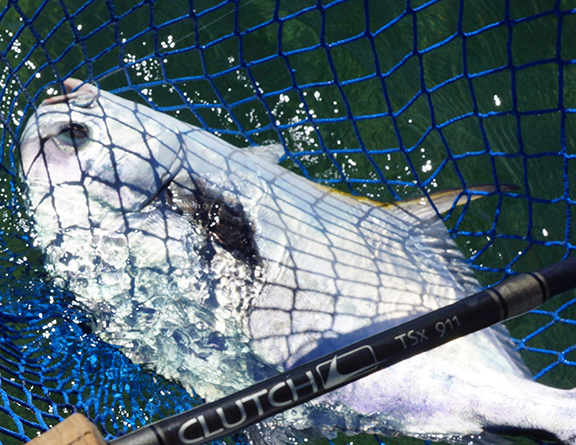Why don’t we use nets for smaller fish like bonefish, permit and smaller redfish? The answer is often “I don’t need one.” or “well that’s the way it’s always been done.” But there is a real argument to using a landing net for saltwater species. It can redeuce stressfor both the fish and the angler.
The best practice for fish handling as endorsed by many leading authorities is to not handle the fish at all, simply follow the leader down the its mouth and remove the hook. This keeps the fish in the water and is minimally invasive. However, this is not often possible, fish take hooks deep, clients want photos, fish have to be transported somewhere else to avoid sharks, the list goes on. Even fly fishing can put strain on fish and fisheries for all of these reasons, nets can help us minimize the impact.
 If a shark swims up on the flat for a taste of your prized bonefish, netting the fish will quickly get it out of the water without you having to wrestle it. Then the fish can be put in the live well of your boat for easy transportation. This can all be done without you having to touch the fish.
If a shark swims up on the flat for a taste of your prized bonefish, netting the fish will quickly get it out of the water without you having to wrestle it. Then the fish can be put in the live well of your boat for easy transportation. This can all be done without you having to touch the fish.
In the world of trout fishing, this was once the case as well. A net is not needed to land most trout. Eventually rubber landing nets became the standard. They protect fish and make landing them easier. Nets prevent the fish from swimming away and forcing you to re-fight the fish back to your hand. Even if the fish is never taken out of the water, netting it can help with hook removal. Rubber nets also keep slime on the fish. Anyone who has handled a bonefish knows how much slime these little fish cary on them. And that slime is crucial for the fish’s health. Preventing parasites from latching on and helping them escape from predators.
People sometime lose permit and tarpon at the boat. Many times the permit will break off after many failed attempts of tailing the fish. This alone should be incentive to carry a net. There are saltwater anglers that fish with nets. Famed keys guide Bob Branham uses one. Permit fishing can be stressful enough, why not take some of the stress out by making landing the fish easier.
 Nets like the Fishpond Nomad nets. The Boat Net and the El Jefe are the best sizes for saltwater species. These nets work great for a few reasons. The first is the rubber mesh. For slimy fish like bonefish, the rubber will keep the slime where it belongs, on the fish. Typical mesh nets will remove a lot of the fish slime. These nets also float like a cork, so if it goes overboard, just grab it. If you and your friend are doubled up on fish and there is only one net, just thrown them this net and let it float to them.
Nets like the Fishpond Nomad nets. The Boat Net and the El Jefe are the best sizes for saltwater species. These nets work great for a few reasons. The first is the rubber mesh. For slimy fish like bonefish, the rubber will keep the slime where it belongs, on the fish. Typical mesh nets will remove a lot of the fish slime. These nets also float like a cork, so if it goes overboard, just grab it. If you and your friend are doubled up on fish and there is only one net, just thrown them this net and let it float to them.
When it is time to net and land a fish, do not go diving around in the water scooping for the fish, this is the best way to lose fish. Many anglers will often miss the fish and strike the leader. Instead, wait until the head of the fish breaks above the water, then net it, just like when you would grab the leader with your hand. Once it is in the net you will be able to handle the fish with ease, remember not to handle fish with dry hands. Fish’s slime is important to them, it prevents parasites and deters predators, and dry hands remove it.
Netting a fish does not mean removing it from the water every time, it just means having less of an impact on the fish and hopefully improving mortality rates. While there is minimal research done on landing nets effectiveness on mortality, it is at least worth having one to not loose permit at the boat. Remember that whenever you handle fish to keep them in the water. If you must take them out of the water, do not hold them out for long. Fish do not have lungs like we do, so they can not hold their breath. Handle fish gently when grabbing their bellies and have a firmer grasp around their tail.


